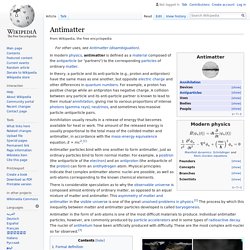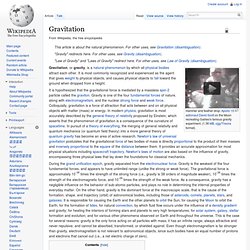

Black hole. A black hole is defined as a region of spacetime from which gravity prevents anything, including light, from escaping.[1] The theory of general relativity predicts that a sufficiently compact mass will deform spacetime to form a black hole.[2] Around a black hole, there is a mathematically defined surface called an event horizon that marks the point of no return.

The hole is called "black" because it absorbs all the light that hits the horizon, reflecting nothing, just like a perfect black body in thermodynamics.[3][4] Quantum field theory in curved spacetime predicts that event horizons emit radiation like a black body with a finite temperature. This temperature is inversely proportional to the mass of the black hole, making it difficult to observe this radiation for black holes of stellar mass or greater. Objects whose gravity fields are too strong for light to escape were first considered in the 18th century by John Michell and Pierre-Simon Laplace. History General relativity. Antimatter. In modern physics, antimatter is defined as a material composed of the antiparticle (or "partners") to the corresponding particles of ordinary matter.

In theory, a particle and its anti-particle (e.g., proton and antiproton) have the same mass as one another, but opposite electric charge and other differences in quantum numbers. For example, a proton has positive charge while an antiproton has negative charge. A collision between any particle and its anti-particle partner is known to lead to their mutual annihilation, giving rise to various proportions of intense photons (gamma rays), neutrinos, and sometimes less-massive particle–antiparticle pairs. Annihilation usually results in a release of energy that becomes available for heat or work. The amount of the released energy is usually proportional to the total mass of the collided matter and antimatter, in accordance with the mass–energy equivalence equation, E = mc2.[1] Formal definition[edit] History of the concept[edit] Notation[edit]
Gravitation. Gravitation, or gravity, is a natural phenomenon by which all physical bodies attract each other.

It is most commonly recognized and experienced as the agent that gives weight to physical objects, and causes physical objects to fall toward the ground when dropped from a height. During the grand unification epoch, gravity separated from the electronuclear force. Gravity is the weakest of the four fundamental forces, and appears to have unlimited range (unlike the strong or weak force). The gravitational force is approximately 10-38 times the strength of the strong force (i.e., gravity is 38 orders of magnitude weaker), 10-36 times the strength of the electromagnetic force, and 10-29 times the strength of the weak force. As a consequence, gravity has a negligible influence on the behavior of sub-atomic particles, and plays no role in determining the internal properties of everyday matter. History of gravitational theory Scientific revolution Newton's theory of gravitation General relativity.
Dark energy. Adding the cosmological constant to cosmology's standard FLRW metric leads to the Lambda-CDM model, which has been referred to as the "standard model" of cosmology because of its precise agreement with observations.

Dark energy has been used as a crucial ingredient in a recent attempt to formulate a cyclic model for the universe.[8] Nature of dark energy[edit] Many things about the nature of dark energy remain matters of speculation. The evidence for dark energy is indirect but comes from three independent sources: Distance measurements and their relation to redshift, which suggest the universe has expanded more in the last half of its life.[9]The theoretical need for a type of additional energy that is not matter or dark matter to form our observationally flat universe (absence of any detectable global curvature).It can be inferred from measures of large scale wave-patterns of mass density in the universe. Effect of dark energy: a small constant negative pressure of vacuum[edit] .